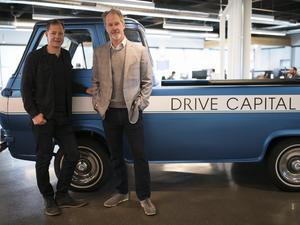
Last year Drive Capital LLC invested $300 million in tech startups, the highest in its 10-year history, and returned more than that to investors, co-founder and Partner Chris Olsen said.
Results like that are part of the reason that 95% of past limited partners re-invested in the Columbus VC firm's latest funds totaling $1 billion – many for larger amounts than before, Olsen told Columbus Business First.
Drive last week announced it had secured final commitments for $400 million for a Fund IV focused on early-stage startups – topping a $350 million goal – and $600 million in a second Overdrive fund for larger growing companies.
"What's been great is our initial investors have continued to invest and many of them have continued to invest more," Olsen said. "And we were able to do it in a faster time period than we've never done before."
Fundraising started in earnest in September until the final deal last week. LPs don't actually hand over a huge check; VC firms draw down the funds as they back startups. Drive now has $2.2 billion under management, the largest firm in the Midwest.
Drive's most recent exit came in February: Chicago manufacturing tech company Fast Radius went public in a reverse merger at a valuation of $1.4 billion – even as several other SPAC deals were canceled around the country, sister publication Chicago Inno reported. Drive owns 19%, according to a regulatory filing.
Previous Drive companies that went public are Columbus' Root Inc. and Pittsburgh-based Duolingo Inc. After a required lock-up period, the firm has distributed in-kind shares to LPs while keeping substantial stakes. Some undisclosed portfolio companies were acquired, Olsen said, generating cash payouts.
The two dozen companies in the portfolio together have created 8,000 jobs, which is expected to double this year, Olsen said. The next $1 billion to invest should result in 16,000 more jobs.
Drive's investment thesis since inception in 2013 is to build tech companies in the middle of the country, where they have the best access to the majority of U.S. engineering graduates and Fortune 500 customers – and where Drive has little competition from coastal VCs to get in at the earliest stage for a larger stake.
With the new funds, Drive has expanded its traditional Midwestern territory to everywhere "between the Hudson River and the Rocky Mountains."
"Now we can offer the same kind of programming in places like Austin or Atlanta or Denver, which I think is really exciting," Olsen said. "Because we're finding this investment model that we built here in Columbus, it works."
More from our conversation, which has been edited and condensed:
You started raising during a high-flying year for VC, but the industry had a rapid downturn this year. How were you able to keep raising? As much as the macro environment has shifted around us – and for sure, we see it and feel it – we still saw a substantial demand for these investment funds in the market.
Why? The macro trend here is: Technology continues to sprout out of Silicon Valley, and now seep its way into every single business on Earth. So there's no such thing as an insurance company anymore; there are only technology-enabled insurance companies. There's no such thing as a transportation company anymore; there's only technology-enabled ones.
It's happening on a global basis – in the corners of the world where that traditional industry exists. And that's why this corner of the world is so attractive to the investment community, who's looking at this and saying, the majority of the GDP is in places like here. And that's where the entrepreneurs are building the companies of tomorrow. That's why people have been so excited by this.
When you do the math on it, it starts to point to a creation of value in the next 10 years, that dwarfs even that which we saw in the prior 10 years, and this trend is only accelerating.
At the same time, some of your portfolio companies are struggling. Some are cutting jobs, pivoting or freezing hiring, and the ones that went public have seen their stock prices fall. Apparently, the LPs were not bothered by that, so why? Well, this is a long-term game. And as much as I wish that our public companies went up in value, the reality is, the decline in value is still – on an absolute basis, it makes them fantastic investments for our LPs. A lot of the companies that we have seen go public have also continued to hang on in value. Over the long term, we still believe in the fundamentals of these businesses, that they are bringing technology to enormous industries. And while they might miss a quarter or two, or maybe even a year or two, long term, the trends are in their favor.







